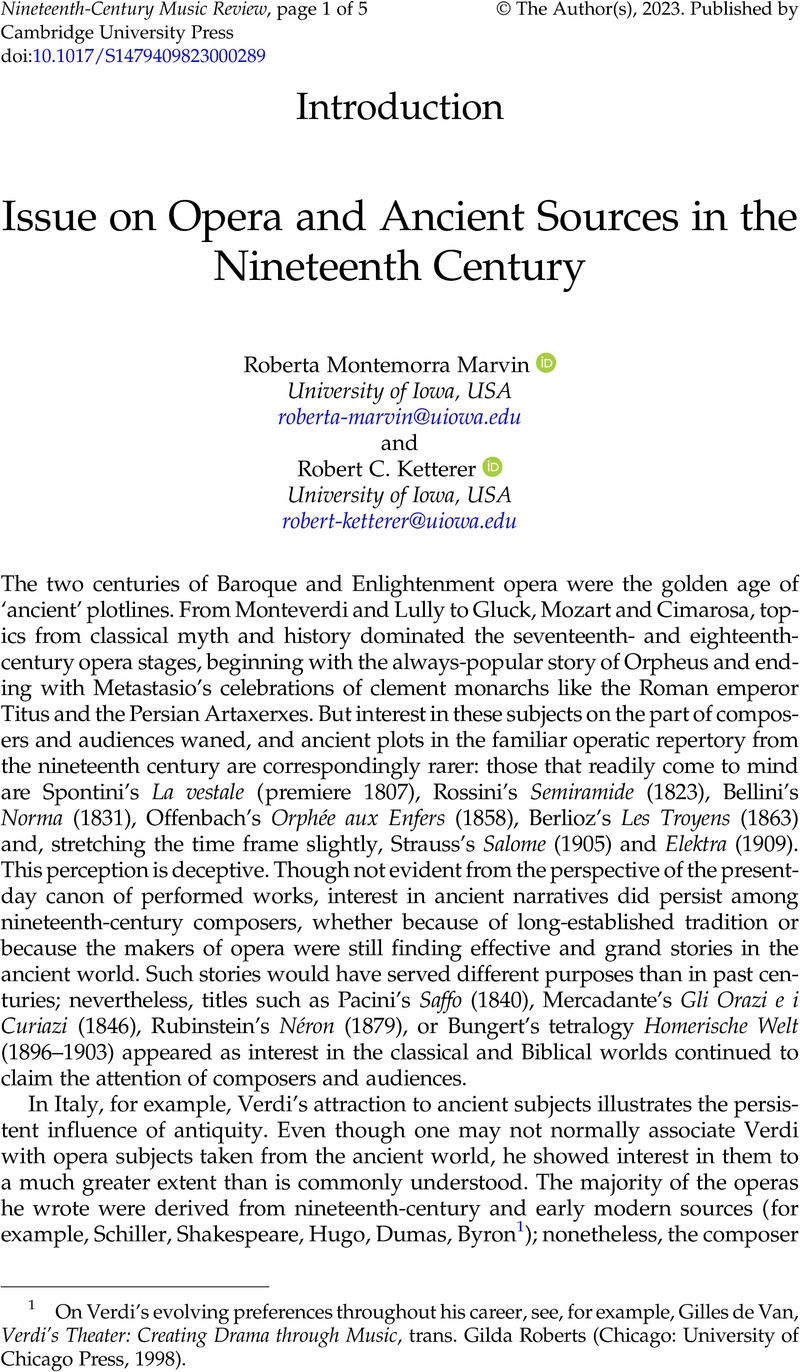No CrossRef data available.
Article contents
Issue on Opera and Ancient Sources in the Nineteenth Century
Published online by Cambridge University Press: 06 September 2023
Abstract

- Type
- Introduction
- Information
- Copyright
- Copyright © The Author(s), 2023. Published by Cambridge University Press
References
1 On Verdi's evolving preferences throughout his career, see, for example, de Van, Gilles, Verdi's Theater: Creating Drama through Music, trans. Roberts, Gilda (Chicago: University of Chicago Press, 1998)Google Scholar.
2 It has been proposed and refuted that elements in the libretto of Aida resemble other Egyptian-based sources. Among these can be counted Metastasio's libretto Nitetti (Vienna, 1756), which, as Metastasio noted in his published Argomento, had some origins in the ancient Greek historians Herodotus and Diodorus Siculus. See Budden, Julian, The Operas of Verdi, 3 vols (New York: Oxford University Press, 1981): 3:165–6Google Scholar.
3 On subjects Verdi considered in general, see Marvin, Roberta Montemorra, Verdi the Student – Verdi the Teacher (Parma: Istituto Nazionale di Studi Verdiani, 2010): 96–107Google Scholar; on the titles found in a short list of potential subjects written in Verdi's Copialettere, see also Rizzuti, Alberto, ‘Argomenti d'opere’, in Verdi e le letterature europee, ed. Pestelli, Giorgio, Quaderni 25 (Turin: Accademia delle Scienze di Torino, 2016): 71–107Google Scholar, and on problems surrounding Verdi's reference to Arria, esp. 101–4.
4 Verdi to Cesare De Sanctis, about the subject Paoli, 18 January 1854, Carteggi verdiani, ed. Alessandro Luzio, 4 vols (Rome: Reale Accademia d'Italia – Accademia nazionale dei Lincei, 1935–47): 1: 22–3.
5 Verdi explained his libretto preferences to De Sanctis, 1 January 1853, Carteggi verdiani, 1: 16–7.
6 Florimo, Francesco, La scuola musicale di Napoli e i suoi conservatori, 4 vols (Naples: Morano, 1880–84): III (1883):116Google Scholar: ‘E davvero nei soggetti tolti dalla storia romana, il Mercadante sa trovarsi in largo campo, nel quale spazia la sua fantasia.’
7 ‘Capitol Terrorists Take Inspiration from Ancient World’, Pharos, 14 January 2021, http://pages.vassar.edu/pharos/2021/01/14/capitol-terrorists-take-inspiration-from-ancient-world, accessed 6 March 2021. One may note in this connection a US president's espousal of classical architecture for Federal buildings, which generated a response on the blog of the Society for Classical Studies after the 6 January attack; https://classicalstudies.org/scs-blog/elizabeth-w-thill/blog-classical-architecture-and-attack-capitol, accessed 6 March 2021.
8 Rachel Poser, ‘He Wants to Save Classics from Whiteness: Can the Field Survive?” The New York Times Magazine, 2 February 2021; updated 12 February 2021.
9 For a journalistic account, see ‘The Myth of Whiteness in Classical Sculpture’, The New Yorker, 29 October 2018.
10 For a survey of scholarship on opera and classics from the seventeenth to the twenty-first centuries, see ‘Classics and Opera’, ed. Robert Ketterer and Jon Solomon, Oxford Bibliographies Online, www.oxfordbibliographies.com, accessed 8 July 2020. General studies and collections include Ancient Drama in Music for the Modern Stage, ed. Peter Brown and Suzana Ograjenšek (Oxford: Oxford University Press, 2010); Ewans, Michael, Opera from the Greek: Studies in the Poetics of Appropriation (Aldershot: Ashgate, 2007)Google Scholar; special issue of Syllecta Classica 23 (2012), https://muse.jhu.edu/issue/27519, accessed 11 July 2020; Danielle Porte, Roma Diva: L'inspiration antique dans l'Opera, vol. 1: L'istoire romaine dans les oeuvres de 1800 à nos jours (Paris: Les Belles Lettres, 1987).
11 For the most complete exposition of eighteenth-century opera seria as a celebration of monarchy, see Feldman, Martha, Opera and Sovereignty (Chicago: University of Chicago Press, 2007)CrossRefGoogle Scholar.





